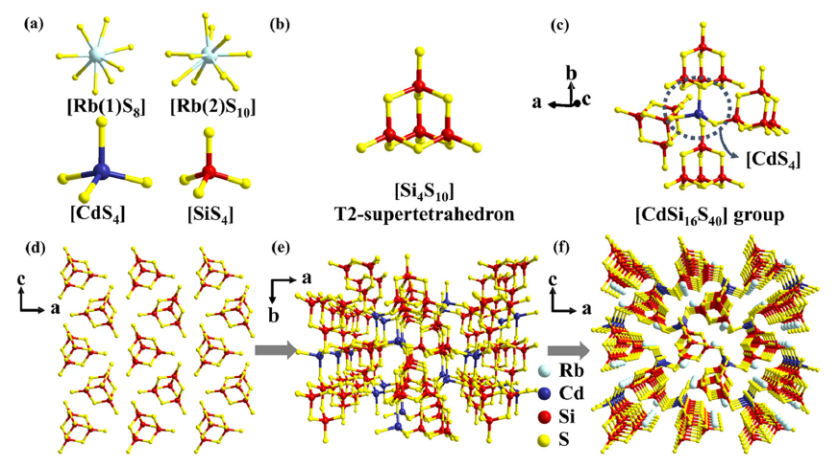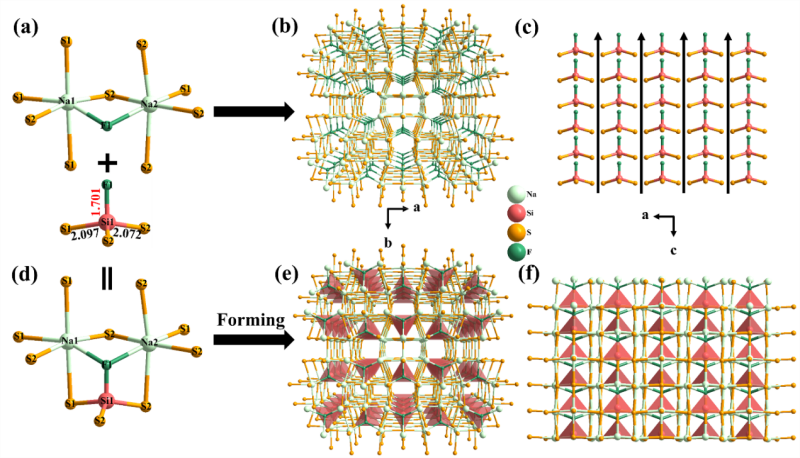The Development of Wide Band Gap Chalcogenide Infrared Nonlinear Optical Materials
Editor: | May 22,2023
Infrared nonlinear optical (NLO) materials, as the core devices of all-solid-state lasers, have tremendously contributed to the progress of many advanced technologies, such as long distance laser communication, environmental monitoring and photonic technologies, etc. Compared with the ultraviolet NLO materials, the development of mid- and far-IR NLO materials is limited by the requirements of a wide IR transparent window, high laser damage threshold (LDT) and strong NLO effect. To date, only a few chalcopyrite-like (CL) candidates including AgGaS2 (AGS), AgGaSe2 (AGSe), and ZnGeP2 (ZGP) are commercially available in these regions, owing to their large second harmonic generation (SHG) responses and wide IR transparency. Nevertheless, the small band gaps (Eg) induced low LDT and two-photon absorption (TPA) in these materials have limited their further applications in high-power lasers. Hence, the exploration of new IR NLO materials with wide band gap and large SHG response is an urgent need but still challenging due to the competition between the wide band gap and large NLO coefficient in one material.
Recently, the research group from XTIPC has designed two wide band gap chalcogenide IR NLO materials: Rb2CdSi4S10 and Na3SiS3F. The introduction of [Si4S10] super-tetrahedra and [SiS3F] mixed anionic units effectively broadens the band gaps of chalcogenide IR NLO materials to t 4.23 eV and 4.75eV respectively, and generates high laser damage thresholds of about 5 × AgGaS2 at 1064 nm. Furthermore, Rb2CdSi4S10 displays a suitable SHG response (0.6 × AgGaS2) with a type I phase-matching behavior. The results were published in Materials Horizons with the title of “Rb2CdSi4S10: novel [Si4S10] T2-supertetrahedra contained infrared nonlinear optical material with large band gap” and Advanced Optical Materials with the title of “Na3SiS3F: A Wide Band Gap Fluorothiosilicate with Unprecedented [SiS3F] Unit and High Laser-Induced Damage Threshold”.
Links: https://doi.org/10.1039/D2MH01200F;
https://doi.org/110.1002/adom.202300736

Fig. 1 The crystal structure of Rb2CdSi4S10. (a) The coordination environments of Rb, Cd, and Si atoms; (b and d) the formed [Si4S10] T2-ST units; (c and e) the formed [CdSi16S40] unit and framework; and (f) the 3D structure of Rb2CdSi4S10.

Fig. 2 The crystal structure of Na3SiS3F. a,d) The coordination environments of Na(1), Na(2), and Si atoms. b) The formed [Na2S9F]∞ framework. c) The well-arranged [SiS3F] units along c direction. The 3D framework structure of Na3SiS3F along e) c and f) b directions.

Fig.3. (a) The experimental band gap, (b) SHG intensity vs particle sizes with AGS as the references at 2.09 μm radiation, (c) optical spectra of Rb2CdSi4S10. (d and e) the typical PM chalcogenide IR-NLO candidates with (d) Eg ≥ 3.5 eV and (e) Eg ≥ 4.0 eV.
附件下载:
 (86) 991-3838931
(86) 991-3838931 lhskj@ms.xjb.ac.cn
lhskj@ms.xjb.ac.cn (86)991-3838957
(86)991-3838957 40-1 Beijing Road
Urumqi, XinjiangChina
40-1 Beijing Road
Urumqi, XinjiangChina